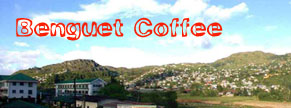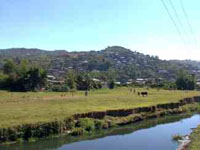
In Benguet, we say "Mankapi tako adi."
If the sights and sounds of Benguet were to be reduced into a travelogue -- say, a 30-second television plug -- it would showcase a flow of distinct images. Roads winding up the rugged terrain of towering mountains, cloud-swept pine-covered slopes, a city nestled in mountains, entire valleys of vegetable greens, tribespeople celebrating a cañao, farmers toiling in the early morn, hardy miners emerging from tunnels, trucks bursting with leafy greens and passengers, a Dangwa bus teetering on a steep curve, spearate huddles of men and women in traditional costumes of red and black hues, dark brown-red coffee ladled smoking-hot from a vat into cups of all shapes and sizes, a hornbill perched on a limestone crag, cogon-grass huts in faroff hills. Accompanied by the shifting sounds of gongs and drums, of the occasional chant (oooo-aaaiii!), segueing to American country music performed by Igorots, and ending with the sound of rushing rivers, babbling brooks, nightbirds, then crickets.
The Post-Election 2004 Edition
Politics is a national obsession. Benguet is not an exception, yet we do it in our own inimitable way.
REMARKABLE UPSETS! The polls showed a clear win for Borromeo Melchor for the governorship and Samuel Dangwa for the congressional seat. Melchor is newcomer in the political game but not in government, having served as NIA director with a clean reputation. His election to the governorship overturns the traditional route to the post: that of occupying lesser political offices first before going for the big one. He beat Edna Tabanda, a wonder woman of sorts in Benguet politics, now outgoing Vice Governor. This is Mrs. Tabanda's second run for the top executive post. She lost to Molintas in '98. [A curious note: Mr. Melchor owns a house right next to the old Tabanda residence in my Kalye Onse neighborhood in La Trinidad.]
The grizzled Samuel Dangwa beat the flashy Rocky Molintas and it is likely that not a few sighs of relief are heard. That means Ronnie Cosalan will have a heralded return in 2007.
In Baguio, an electorate scandalized over parking fee scandals and casino re-opening plans have trashed Bernardo Vergara out of the mayor's office and gave a landslide win for former Judge Braulio Yaranon, a known oppositor to such dubious development plans.
Over the years, Baguio's landscape has dramatically changed with the influx of big businesses. Some of it has shocked the small-town sensibilities of Baguio, which has to have a plan to cope with overcrowding, traffic and urban blight. Okay, so overpasses are helpful but not if they are astronomically priced and aesthetically questionable
The electoral victories of Melchor, Dangwa and Yaranon over their flashier rivals can be interpreted as a popular call for sobriety, decency, and roll-up-our-sleeves hard work. Those who lost are unfortunately tainted with rumors of lucrative legerdemain while in office and whether these are true or not, the public is not in the mood to play the tolerant type.
30 May 2004
Read pre-election thoughts.
***
Transplanted Benguet
Should Ronald Mc Donald, the burger-and-fries king, dominate the skyline of the Salad Bowl of the Philippines? A shame!<Read my musings>
***
VISIT THE NEWS AND VIEWS
****
Very Benguet
A Benguet Etymology (Excerpt from Sacla's Treasury of Beliefs and Home Rituals of Benguet)
Who are the Igorots? (Excerpt from Scott's The Discovery of the Igorots)
Visual Benguet
Exploited Benguet
Benguet's gold has lured Spanish, American and Japanese colonizers across four centuries. In the first half of the 1900s, the Americans intensively made inroads in the province, opened up Benguet's earth, and inveigled tribespeople to yield the wealth of their land. This set a pattern of heavy-handed exploitation that undermined the environment and local socio-political institutions.
Benguet's waters are up for corporate grabs.
A mining town sinks. Is it natural phenomena?
GUESTBOOK
LINKS
Hot, Caffeinated Sites
The Shameless I Love Coron Page, a shameless plug for my Coron tribute, hahaha!
An Ilocos Summer, a personal photo album of a visit to the remote beaches of Pagudpud and the baroque churches of Ilocandia.
Tonette Go, Southern belle and true adventurer (from Surigao to Mississipi to Bangkok!)
The Coffee Kid more stuff for bean brewers and brewees!
The Environmental News Network, hey, what's happening to the planet?
The Carat Center, Inc. not a jewelry shop but a source of Benguet Coffee and other Cordillera products
This edition posted 09 April 2004.
All rights reserved, except for material expressly sourced elsewhere.
For queries, contact ferdibee@geocities.com.
